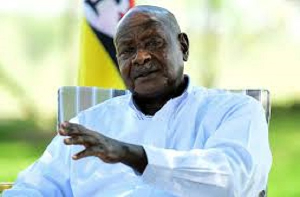BENING R. Bagulo, 2005. University for Development Studies in the History of Higher Education in Ghana, 2005 (157 pp; including one map and one table). ISBN 9988-8258-8-9. Published by Tahawah Publications, Accra; available at Legon Bookshop, UDS Campuses --Tamale & Wa.
Reviewed by Sundong Abdul-Korah
The colonial master’s exploitative tendencies, like a monkey on a maize farm, completely denied him of any commonsense. In 1899, Gold Coast Governor Sir F. M. Hodson declared: “The country as far as I know is destitute of mineral wealth, it is destitute of valuable timber, and does not produce either rubber or kola nuts or indeed any product of trade value…I would not at present spend upon the Northern Territories…a single penny more than is absolutely necessary for their suitable administration and the encouragement of the transit trade.” A Chief Commissioner would later lump together the Northern people as a lumpen proletariat: “...an amiable but backward people, useful as soldiers, policemen and labourers in the mines and cocoa farms; in short fit only to be hewers of wood and drawers of water for their brothers in the Colony and Ashanti.” The colonial government’s decision to bar the inhabitants of the Northern Territories as well as those of the Northern Section of Togoland from attending the few secondary schools in the Gold Coat Colony merely re-emphasized his moral bankruptcy.
This perfect condescension and determined deprivation of the northern people would make Kimble wince: “Since 1901 the Northern Territories had been legally as well as territorially attached to Gold Coast, their trade had been directed towards the sea rather than the desert, they had been governed at least on paper from Accra, and they became subject to a similar pattern of British influence. Yet the northern peoples remained physically and psychologically remote, they were in the Gold Coast and yet not of it.”
Such outrageous policies angered decent and discerning elite natives who argued rigorously for rationality to prevail, and appealed to their compatriots to remember that the Northern Territories formed an important boundary with adjacent foreign states; hence it was only prudent to empower her peoples educationally so that they could defend these boundaries for the country in times of crisis. After all, self-government also meant the ability to defend oneself in any direction and in any sphere of life. The victory of such rational reasoning is abundantly evident today, and is beautifully mirrored at many fronts and fields of endeavour.
This piece of work by R. B. Bening is but one such tribute to the era of fairly illuminating sanity that unveils the latent powers of hitherto underprivileged collective mind, which has emerged from the doldrums to remind us, among others, of the fragrance of nasty and sweet lavenders—futility and fruitfulness. The laborious, proven political geographer and researcher, like those determined exploitative colonial miners with shovels on our glittering soils, has dug deeply the silent, dark and rusty but rich archives of both the distant and immediate distance mirrors, bringing to the fore a sparkling and startling revelation worth our attention. The work is advertently inundated with relevant references thanks mainly to primary sources, which he has brilliantly stringed together with other crucial secondary materials. Such is typical of, and reveals professor Bening’s pen and works.
The book’s essential essence to the contemporary as well as its potential propensity to our progeny is aptly and firmly fore grounded. In the preface, he acknowledges: “My long-standing interest in educational development sustained a patient and assiduous search for various reports and documents, particularly those that were not published and should not be lost to the people of Ghana.” The book takes a general overview of tertiary education in Ghana, giving historical accounts of the formation of the various public universities, exploring and plunging deeper into the inherent challenges, political correctness and drowsiness, among others, that often characterized their siting and establishment. Undoubtedly, the formation of the University for Development Studies (UDS) takes a centre stage in this regard.
The author is mindful of the pioneering role of great Achimota college as well as the colossal contribution of the early missionaries: “A study of the development of modern universities in Ghana cannot fail to recognize the pioneering efforts of particularly the missionaries in formal education which initially brought the gates of higher learning institutions in Europe closer to the people along the coasts.” He also takes pains to wind back the clock to remind us that as late as 1943 full university facilities were available, but only in a very small part of the British Colonial domain. These are the Royal University of Malta (1769), the Hebrew University of Jerusalem (established after WWI), the University of Hong Kong (1911) and the Medical College at Colombo, Sri Lanka, formerly Ceylon (1870).
Thus early scholars and professionals from West Africa were educated or trained abroad, who upon return, were often vulnerable to suspicion and victimization in times of political unrests. This lack of higher institutions of learning, Bening points out, impeded development since University work, in its widest sense, is defined to include the comradeship of learning and the emergence from pupil to adult status. Higher education is not merely the acquisition of knowledge, but a way of life. “Europe’s remarkable progress in the early middle ages could scarcely have been accomplished without the help and inspiration of her schools of learning,” an authority succinctly states.
The book is conveniently compartmentalized into four parts: the first part deals with some aspects of Public Institutions of Higher Education in Southern Ghana. It explores the need for university colleges in British West Africa, giving a lucid account of the agitation for the University College of Gold Coast, which was later founded as University of Ghana (UG) in 1948. It provides a background to the establishment of Kwame Nkrumah University of Science and Technology (KNUST), University of Cape Coast (UCC), University of Education (UW) and University of Mines and Technology (UMT). This section discusses further some significant developments in Achimota College.
The second section gives a comprehensive account of the appalling colonial policies on education in Northern Ghana and the consequent demands for a University in Northern Ghana. It reveals vividly the tortuous path that led to the creation of UDS in May 1992, whose gathering clouds began but could only form raindrops after almost four decades.
The author notes authoritatively that like many other institutions in the country, the establishment of UDS was another political pendulum that swung violently in many directions, metamorphosing in form and content over its embryonic years. From the early 1950’s when these demands were made, which proposals eventually got the formal consent of President Nkrumah in 1964, its location hovered from Pong-Tamale, Somanya to Nyankpala and Sumbrumgu near Bolgatanga before its present non-nucleus location in Tamale, Navrongo, Kintampo and Wa. Its initial primary aim was to support Agriculture in the area. Part three deals with the Nature of University for Development Studies. The University opened with three faculties: Faculty of Agriculture, Faculty of Integrated Development Studies and School of Medicine and Health Sciences. The university’s present multi-campus outlook is modeled on the Community College and the Land Grant University of the USA. It is said to be research based and practical oriented, divorced from the purely academic courses taught in orthodox universities which churn out people primarily for white-collar jobs.
Bening laments that the implementation of the multi-campus formation of the university in towns in Northern Ghana was replete with awesome rivalry. Relocation of some campuses and faculties were carried out amidst convulsive protests, particularly among the people of Tamale who misconstrued the initial settlement in Tamale to mean that the university was solely to be planted there, hence the fierce resistance by some indigenes when some campuses were relocated at Navrongo and Wa. Unfortunately, some loud voices lent credence to these demonstrations against the vice-chancellor which were insulated with venom. “He [Vice-Chancellor] has assumed a prerogative that is not his and exercised it wrongly.”
The final section of the book discusses the geographical, economic and historical factors as well as the political considerations that influenced the siting of public institutions of higher education in Ghana. The author asserts that the location of the first institution of higher education in the Gold Coast generated similar heated debate. Perhaps this is only to be expected. As he has eloquently observed in his Ghana: Regional Boundaries and National Integration, during the integration of the autonomous Colonies of the Gold Coast, demarcation of lands created disputes between some communities “as it was fully appreciated by the people that the boundary would determine the limits of jurisdiction of native authorities and the confines of the lands subject to the settlements on either side of the boundary, the conflicting claims in the borderland persisted and led to inter-communal riot.” He affirms that political officers on either side were inclined to support the people under their jurisdiction and to uphold their claims.
These antecedents probably suggest why, even in modern times, Regions, District Assemblies and Communities usually scramble for the location of important development projects such as schools and hospitals in their respective localities. Such tendencies permeate the author’s discourse and orientation, which he has expounded in this section. “The prestige and benefits of a town’s association with a university are obvious and several communities have shown keen interest in their location and have competed in attracting them to their vicinities.”
One major tributary to this ‘river’ is the address the first Vice-Chancellor (author) delivered at the historic congregation for the award of degrees to the first three batches of students of the University for Development Studies (UDS) at Tamale in November 2000 where many people did not only demand copies of the speech but also requested for its expansion to its present form. The other leveraging wing is the author’s realization that early works on education have focused primarily on pre-university education, leaving authoritative works on institutions of higher education in Ghana pitifully scanty, superficial and of recent vintage.
Bening’s University for Development Studies in the History of Higher Education in Ghana is remarkably hewn like rainbow-beads on the spiral neck of an African queen: an impressive historical narrative that lays bare discriminatory, strangulating colonial policies; a vivid exposition of tense debates and views of committees made of academics, educationists and politicians, which eventually culminated in the establishment or non-establishment of some institutions of higher learning in Ghana.
The author lays a bold claim to the effect that some deliberate policies were precisely responsible for the vast inequalities in the Gold Coast, and these factors still linger, tincture and engender the disparate disparities in contemporary Ghana. This account is seemingly a prescriptive dosage for national consciousness and assertiveness. The colonially baptized ‘ethnocentrist’ may, hopefully, find every reason to go through these reflective and transformative pages with excitement. Nonetheless, some aspects of its beauty may be lost to uncritical readers.
What you are about to read is certainly not a story book, yet its punctuated references are more than thrilling melodies, requiring sufficient reflective pauses for a good laugh and sour anger; perhaps so deliberately designed for a fuller understanding of the book’s very substance. This work is a serious tragicomedy staged for our viewing pleasure by Colonialists, Politicians, Governments, Scholars, Opinion leaders and Activists, which a skilful artist with rainbow-crayon has aesthetically painted.
While editing errors plague some of the chapters, many of the shortcomings of this first edition will likely be alleviated by later editions. These problems are only a minor distraction to the story being told.
General News of Wednesday, 9 September 2009
Source: Reviewed by Sundong Abdul-Korah












